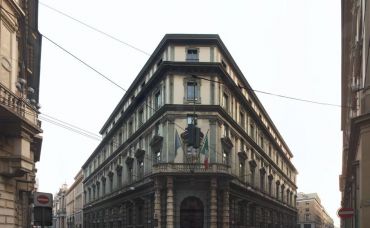Madama Palace, Turin

Madama Palace in Turin (Palazzo Madama) is one of the residences of the ruling Savoy dynasty. This building is one of the oldest, monumental and beautiful in the city. In addition, one of the most important, its location in the "white heart" of the capital of Piedmont contributes to it. It, like Palazzo Carignano, it has a double façade that stands out against the background of other palaces. And, like other royal residences, is included in the UNESCO World Heritage List.
History of palazzo
The richest history of the palazzo reaches the beginning of our era. At the beginning of the 1st century, the eastern gate of Porta Praetoria (or Porta Decumana) of the ancient Roman city Augusta Taurinorum stood in place of the present palace. After the fall of the Roman Empire, powerful city gates gradually turned into a fortress. Already in the 9th century it was called the castle of Fibellon and was intended for the defense of the city from the side of the Po River. In the 13th century the fortress became the property of the Marquis of Monferrato, and after a century, it passed into the hands of the younger branch of the royal house, Savoia-Acaja. The new owners have significantly altered the structure to suit their taste and it became known as Castello di Acaya.
Already in the 15th century the Acaya branch ceased to exist, and the castle was used to receive important guests from other countries. In 1578, the Shroud of Turin was publicly displayed here. Prior to the beginning of the 17th century, celebrations of significant events, including royal weddings, were held here regularly. In 1637 and 1697, the castle was inhabited by Maria Cristina and Maria Giovanna of Savoy, who were the regents of their young sons who later became full-fledged rulers. After that, the present name of Madama was firmly entrenched to the palace. Two significant renovations were carried out by the greatest architects of those times: Amedeo di Castellamonte in 1686 and Filippo Juvarra in 1721.
In the 19th century, the Madama Palace in Turin was alternately an observatory, the seating place of the senate of Sardinia and the building of the Court of Cassation. In 1928, another restoration was carried out. And on May 6, 1949 the farewell to the players of football club Torino, who died in a plane crash, took place here. A little earlier, in 1934, the palazzo became the haven for the collections of the City Museum of Ancient Arts, located here and now. At the end of the 20th century, repairs were carried out inside the building, which ended in 2006. The last restoration of the façade took place in 2010.
Architecture and activities
Since the 18th century, the palace has retained the original style created by the architect Filippo Juvarra. The grand façade is made in the Baroque style, which has already become familiar to Turin. It highlights the windows, alternating with pilasters and columns, supporting the monumental balustrade. The latter is decorated with statues and decorative elements of white marble. The whole façade stands out with its bright whiteness, on the background of which the monument of the Sardinian army literally merges.
The interior impresses with its lightness, which is determined primarily by light penetrating from the three large windows. Inside the lobby, four central pillars support the vault above the monumental staircase leading to the main floor. Every room and hall of the palace is richly decorated with stucco and various decorative elements. The rear part of the façade, the gate of Fibellona, remained as powerful and harsh as in the Middle Ages. Apparently,there were not enough money for the full reconstruction.
Inside the building, museum collections are housed on its four floors. The route of excursions to the palazzo is closely intertwined with the museum tour. And if in the latter much attention is paid to the exhibits, the first is devoted to the history of the building and its halls. In addition, the palace regularly holds temporary exhibitions of all kinds of art. Italian poet Guido Gozzano accurately summarized the qualities of the Palazzo Madama, by calling it the "House of Ages", which absorbed the whole history of Turin.
How to get there
Madama Palace is located in the heart of historical Turin, on the Piazza Castello. In the vicinity there are many attractions, including the Royal Palace, the Turin Cathedral, the City Tower and the Sabauda Gallery. On the square there is a bus stop Castello. Trams 7, 13, 15, and buses 13N, 55, 56, 3904, 3991, N04, N10, S04, W01, W15, W60 go to it.
Opening hours: from 10:00 to 18:00. The ticket office closes at 17:00. Tuesday is the day of. Phone number: (+39) 011 4433501.
Admission: the price of the full ticket is 10 euro, with a discount – 8 euro. For people under the age of 18 – admission is free. Also free entry on the first Wednesday of the month. Data of May 2018.







